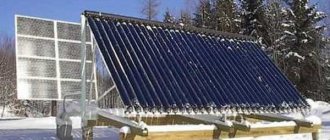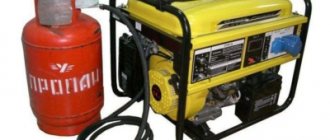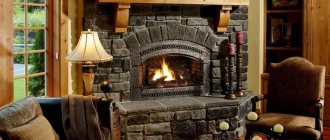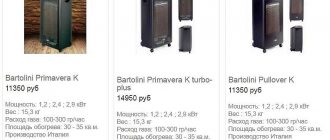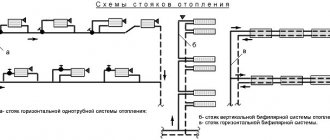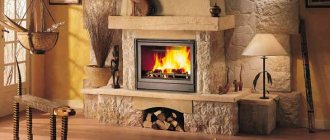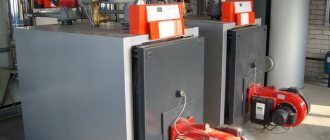An electric heating boiler occupies a special place among other heaters because it is operated without the need to replenish fuel supplies. Gas, which also does not have to be stored, is not available everywhere, unlike electricity.

Induction heater
Simplicity and ease of connection have provided the widest distribution of the electric heater. It is installed in apartments and summer cottages. It is found in northern and southern latitudes. Basically, these are 220 volt units, since the required power in this case does not exceed 12 kW.
A more powerful electric heating boiler is three-phase and requires a 380 V connection.
The advantages of an electric boiler
The electric three-phase boiler is constantly being improved by the developers. Wall and floor models are available.
The best representatives of this class receive additional systems and devices that provide multi-stage regulation, automation of air removal and temperature control processes.
An electric three-phase heating boiler is capable of working in conjunction with other types of heaters. Compactness and design are considered indisputable advantages.
Although an electric heater is not as economical as, say, a gas heater, it still has certain advantages:
- An electric boiler takes up less space than a solid fuel one. It is allowed to be mounted anywhere where there is an electrical network;
- No chimney or additional ventilation is required - this is a direct saving of money and time for maintenance;
- It is not a source of unpleasant odors and carbon monoxide. The boiler is environmentally friendly.
- Almost no noise during operation;
- The absence of open flames makes it easier to comply with fire safety measures.


Electrode boiler
Electric boilers have high efficiency - at least 96%.
The disadvantage of a three-phase boiler is the need to convert the current to 380 V and the presence of good electrical wiring in the house. Electricity is more expensive than gas, and frequent power surges affect the quality of the boiler. This also applies to the minuses.
380 volt boiler - the best heating on favorable terms
- The price is several times lower than that of other boilers.
- They have very high performance as well as heat dissipation.
- The boiler is hung on the wall in the right place, which significantly saves valuable space.
- There is no need to lay a separate pipeline for it, as for gas.
- When installed indoors, the boiler serves as another source of heat.
It must be said that an electric boiler 380 for heating a house, the price for which is quite affordable, is one of the best solutions. These boilers have excellent power, thanks to which they provide efficient heating of any premises. And the affordable price with excellent performance allows these boilers to take a high place among all heating systems.
Varieties of electric boilers
The electric boiler is presented on the market with a wide variety of products. The differences between them are as follows:
- The number of contours. Like other types of heaters, an electric boiler can be single and double-circuit. A single-circuit boiler has a slightly higher output power, since it does not provide for operation with hot water supply.
- Heating element type. It can be a heating element, an electrode or an induction coil (inverter).
- Coolant type. Some single-circuit heater models use antifreeze.
- The type of electrical network used (220 or 380 volts) and the connection method (single-phase or three-phase).
- Heating method.The boiler is of a flow-through or storage type.
To create the increased power, more electrical system performance is required. An electric heating boiler with a capacity of over 12 kW is recommended to be connected to a 380 V network. This requires obtaining a permit and pulling a separate line.
With insufficient water pressure, it can boil!
Cross-sections of electric cables for power supply of electric boilers
I will give an example of the ratings of circuit breakers (table 2) and the cross-sections of the supply cables (table 1) for electric heating boilers.
Table 1
Cross-sections of supply cables for electric heating boilers
| Boiler power | Cable cross-section for single-phase electric boilers | Cable section for three-phase electric boilers |
| up to 4 kW | 4.0 mm2 | |
| up to 6 kW | 6.0 mm2 | |
| up to 10 kW | 10.0 mm2 | |
| up to 12 kW | 16.0 mm2 | 2.5 mm2 |
| up to 16 kW | 4.0 mm2 | |
| up to 22 kW | 6.0 mm2 | |
| up to 27 kW | 10 mm2 | |
| up to 30 kW | 16 mm2 | |
| Up to 45 kW | 25 mm2 | |
| Up to 60 kW | 35 mm2 |
table 2
Ratings of circuit breakers for the power line of the electric boiler
| Boiler power | For single-phase electric boilers | For three-phase electric boilers |
| 4 kW | 25 A | 10 A |
| 6 kW | 32 A | 16 A |
| 8 kW | 40 A | 16 A |
| 10 kW | 50 A | 20 A |
| 12 kWt | 63 A | 25 A |
| 14 kWt | 25 A | |
| 16 kWt | 32 A | |
| 18 kWt | 32 A | |
| 22 kWt | 40 A | |
| 27 kWt | 50 A | |
| 30 kWt | 63 A | |
| 45 kWt | 80 A | |
| 52 kWt | 100 A |
The principle of operation of electric boilers
The work algorithm is simple. First, the coolant is supplied to the expansion tank. It is then heated by electrical energy and then sent to the system.
The design implements the following heating schemes:
- With the help of heating elements. One or two heating elements, connected to the network, heat the water in the tank, like boilers. The heating element boiler is reliable, gives high efficiency and is relatively inexpensive.


Heating element heater device
To increase efficiency, the use of programmers is recommended. These devices provide automation of work depending on the indoor or outdoor temperature. The economic effect from the application is up to 30%. Installation is permissible on our own, but it is better to provide work to professionals.
- The electrode boiler uses the principle of AC heating when passing through water (heat carrier). Automation protects such a boiler from short circuits, leaks and overheating. These devices are sensitive to water quality.
- The induction type boiler uses the principle of heating by electromagnetic induction. The heating element is a coil with a large number of turns of insulated wire and a metal rod in the middle. It is placed in an upright position in a sealed cylindrical body, inside which a coolant is supplied through the lower branch pipe. Power is supplied through terminals installed on the top of the cell body. After heating, it is discharged into the system through the upper branch pipe. Boilers of this type heat up quickly, which requires monitoring the pressure and the presence of water in the system.
Types of electric boilers
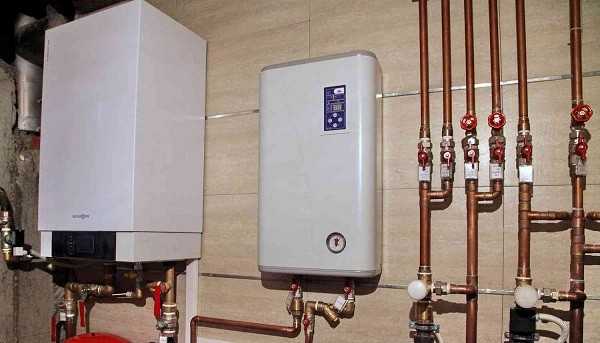

Electric heating boiler
Electric boilers for heating a private house for 380 volts can be heating elements, electrode or induction, depending on the type of energy transfer to the heat carrier. Manufacturers offer floor and wall options suitable for large and standard houses and cottages. They have different degrees of protection and increased efficiency.
Electrical units can be three-phase or single-phase, the first option is usually chosen for houses with an area of more than 100 meters. The power of three-phase boilers starts from 10 kW, the list of their advantages includes stable voltage and circuit protection. However, they are limited in terms of installation, since the installation of a step-down station is required. To find out which of the models to choose, it is better to contact a specialist.
Heating elements
Such units are considered the most popular and work according to the same principle. The tubular element heats the water circulating inside the system, which ensures uniform and fast heating. Inside such a boiler there can be from 1 to 6 heating elements, their number directly depends on the power of the device. The heating element three-phase electric boiler is equipped with a special automation system, due to which the temperature of the heat carrier is monitored and regulated.
The device has a simple and reliable design, easy to install and does not cause problems during use. Boilers on heating elements are quite cheap, almost any liquid is suitable for them as a heat carrier. In addition to the main advantages, modern heating elements are distinguished by their laconic and modern design, which allows them to fit into any interior. It is necessary to use high-quality heat transfer fluids to prevent the appearance of scale.
To reduce scale formation, anode rods are installed to collect excess salts. They can be changed as they wear out, like the heating elements themselves.
Induction
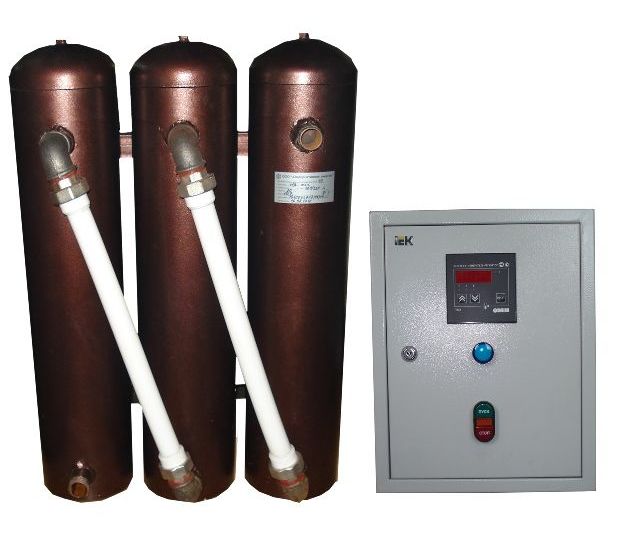

Induction boiler
Electromagnetic induction boilers are often used for residential applications. Inside the cylindrical body of such a device there is a metal core with a coil wound around it. When voltage is applied to the coil, a vortex flow is formed, due to which the pipe with the circulating heat carrier heats the water. To avoid overheating, the water must be circulated constantly.
The efficiency of such devices reaches a maximum value of 98%, which makes induction boilers the most efficient. In addition, a 3 kW electric boiler for 3 phases is not subject to scale formation inside and is considered the safest, since there are no heating elements in it. The induction units can be installed in the shortest possible time due to their low weight and compact dimensions.
An induction heating boiler does not need a circulation pump if it is used in a home heating system. This part is required for large systems in multi-storey buildings.
Electrode


Electrode model
Electrode-type boilers operate on specially prepared water, in which salts are dissolved to increase the density to the desired level. A three-phase electric boiler consists of a pipe into which a pair of electrodes are inserted. Due to the potential difference and polarity change, the ions inside begin to move chaotically, as a result of which the heat carrier heats up faster.
Thanks to the accelerated heating, powerful convection flows heat up a large volume without the need for a circulation pump. Of the advantages of 380 kW electrode devices, compact dimensions, an accelerated achievement of rated power, a simple design and a low accident rate, even if water begins to flow out of the heating system, are noted.
For electrode assemblies, earthing is provided. The boiler and all elements of the heating system in the house are connected to the grounding circuit.
Types of three-phase heaters
The three-phase boiler is characterized by increased performance, quiet operation and compact dimensions.


Homemade induction heater
They are more often used for heating and hot water supply systems in country houses. Double-circuit models are especially popular. Recommended to be installed in combination with other heaters.
Available in two types:
- Electrode. The advantage of such a boiler is the high heating rate of the coolant.
- Induction. This is the most innovative look. Provides low specific power consumption. The disadvantages include a large mass and a relatively high price of equipment. Such units are not produced with high power.To increase it, the method of cascade installation of three heaters at once is used, in which each boiler is connected to a separate phase.
Boilers with heating elements are also produced, but their popularity in private households is declining. Heating elements often have to be cleaned and changed.
Operating rules
Despite the fact that an electric boiler is rightfully considered one of the safest, do not neglect the observance of safety measures during operation. This is especially true for connection.
Primary requirements:
- The connection is made directly to the meter through circuit breakers. Protection ensures safe shutdown of the heater in case of short circuit and sudden voltage surges.
- Correct grounding is essential. There is a scheme in the manufacturer's instructions, non-observance of which entails a waiver of warranty obligations.


Connecting the boiler to the network
During operation, monitor the condition and performance of the so-called safety group of an electric boiler:
- a safety valve that relieves pressure when the permissible values in the system are exceeded;
- pressure gauge - incorrect readings will not allow you to determine the malfunction in time;
- air vent - this design element prevents air from entering the system. Airing is fraught with interruptions in operation, boiling and even failure of the boiler.
The boiler operation is monitored by the automation and control system, which periodically require checking.
Automation regulates the temperature regime, and in case of failures, it issues a shutdown signal. The performance and power of the heater depends on its work. The service life of the elements is 5 years or more, but visual inspection of the operation is recommended by the manufacturers.
It is believed that electrically boilers are safer than others. If installation and operation are carried out in compliance with all requirements, then the boiler will be able to work without problems for 10 or more years.
How to connect a generator
Incorrect connection of the gas boiler to the generator can lead to the inability of the ionisation electrode to distinguish between the flame in the burner. The unit uses an ionisation flame sensor. When the air is ionized, the current begins to move between this flame sensor and the burner. A "zero" is required for a flame to be recognized correctly.
When connecting the gas generator to the boiler, the body is grounded. Based on the design features, most models exhibit "zero". Otherwise, one of the two contacts is taken as zero.
The boiler is grounded. This is necessary in order to achieve maximum electrical safety. In order to control the flame, the neutral wire must be connected to the protective ground. In the initial state, the network has a clear phase and zero. An insulated neutral generator has two equal leads. For safety reasons, the generator housing is also grounded. It is enough to connect it to a common conductor. When any of the equal outputs of the generator are combined with a special grounding conductor, pronounced zero and phase conductors appear on the unit.
If the boiler does not start from the generator, it is necessary to check whether the gas generator is correctly connected to the mains. In addition, you need to check the serviceability of the operated gas boiler. Also, the voltage in the network should not be allowed to exceed 250 volts. In some cases, the external power grid is normalized using a special stabilizer. In this case, the gasoline generator is most often connected directly to the network, bypassing the stabilizer.
If the level of the voltage generated by the gas generator is not enough for the functioning of the gas boiler, you need to contact a service workshop. Very often, a built-in automatic voltage regulator is included in the design of a gasoline unit.It should be borne in mind that when an external stabilizer is connected immediately after the gas generator, a conflict of both stabilizing systems is possible. This conflict must be avoided.
The centralized power grid always has a grounded zero. Thanks to this, the gas generator can be used without grounding work.
The manual phase switch can be replaced with automation. Automatic control of the system can provide complete automation of both the procedure for turning on the electric generator, and a number of other functions. In this case, the opposite inclusion is completely excluded.
Before connecting the gasoline generator to the boiler, you must read the installation instructions. It is best to entrust the determination of the scope, connection and further maintenance of the device to persons with the necessary qualifications.
In many private housing construction, gas boilers are the main source of heat. However, for their effective work, the creation of certain conditions is required. Most of the models of modern gas units are volatile. For them, their uninterrupted power supply is important.
According to statistics, in 85% of cases, the cause of boiler breakdown is unstable power supply. This is due to the fact that modern automation is extremely sensitive to significant voltage surges in the network. A stable supply of voltage to heating equipment can be provided by a gas generator for a gas boiler.
Piping and first start-up of a three-phase boiler
They begin to mount an electric three-phase heating boiler from the calculation of the circuit. It is somewhat more complicated than when connected to a 220 V network, but it is present in the passport to the unit. Since you will have to obtain permission to operate the boiler in the 380 V network, it is better to entrust the connection to the employees of the electric networks.
The most critical part is connecting the wires. The order is indicated in the instructions and is absolutely uncomplicated. The main thing is to observe the color and properly ground the unit.
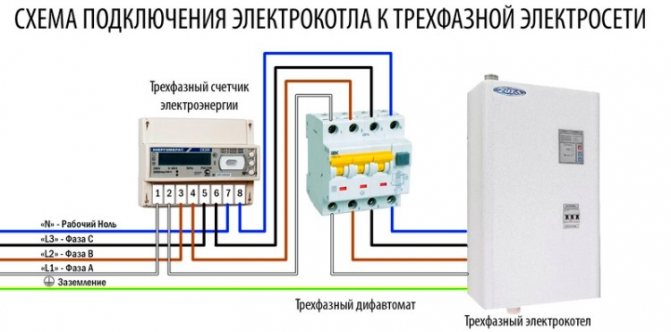

Three-phase connection diagram
It is important to correctly perform the strapping. Correct strapping is a guarantee of high-quality operation of the device. This will require a number of accessories and tools. The work is not difficult for a person who has an idea of plumbing work.
Water must enter the boiler through the return line. This is done in order to be able to add water during the operation of the boiler without the occurrence of cavitation processes. A shut-off valve is installed in the supply line, and a filter is installed in the discharge line.
The same taps are needed in the water supply lines to the heating and hot water systems.
The boiler is mounted at the lowest point of the system. This will allow you to get the maximum heating of the heating system elements. The pipe for supplying the coolant to the radiators is installed at a minimum height from them.
A double-circuit heater must be connected so that the coolant in the small circuit heats up to a certain temperature and is supplied to the large circuit to the radiators.
After the connections are completed, start up. First, remove the front panel and slightly open the tap in the return line so that water begins to flow into the tank.
The control is carried out using a pressure gauge on the device body. The required pressure is limited by the green sector on the device (1.5-2 bar). When the arrow enters this sector, unscrew the cock on the relief valve (installed in the upper part) and completely bleed the air. When water flows without bubbles, it is closed. This will cause the pressure in the tank to drop. Wait until it grows and then bleed the air again.
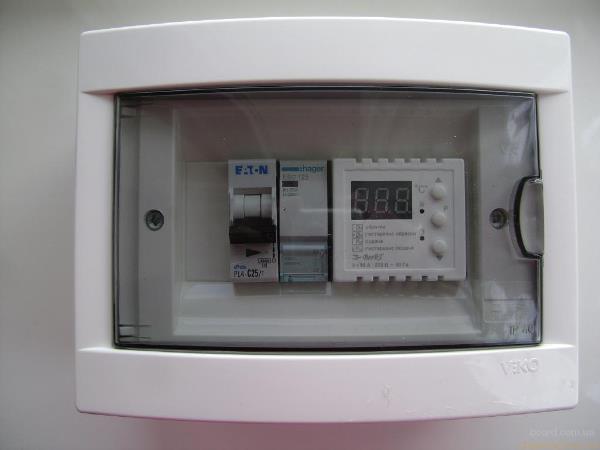

Electric boiler control unit
Then proceed directly to the start-up. To do this, include a gas station. The power lamp on the indicator of the device will light up and digital data on the water temperature will appear.
Pressing the arrow buttons (+ and -) controls the amount of used kW and the water pressure in the boiler. The Mode and OK buttons allow you to program the temperature and power consumption in kW.
After the set temperature has been reached, the pump starts functioning and the heating element turns on. All that remains is to close the lid and enjoy the quiet and fast work. The boiler is stopped by pressing a button with a minus sign and a complete reset of the set temperature.
Connection to the heating system


Network connection diagram
To connect a three-phase boiler, you must adhere to a special scheme. It is better to entrust this process to a specialist who must understand heating devices and know the principles of operation of sensors, pumps and other elements. The diagram for connecting electric boilers to the heating system consists of several standard steps. To avoid possible problems, you need to follow the basic rules:
- To fix the elements of the unit, you need to use plastic pipes or jumpers made of dielectric material.
- The circulation pump is placed on the return pipe.
- A safety group is placed on the pipe for supplying a heated heat carrier.
- When using a small circuit, shut-off valves must be installed after it.
An open expansion vessel should be positioned at the top of the system without the need for locking devices. Closed tanks are placed near the device to the shut-off valves.
Choosing a brand of electric boiler
Today, buying a three-phase boiler for heating does not seem to be problematic. There are a great many manufacturers and versions.
The choice is not easy to make. Be sure to pay attention to the available features and warranty. Buyers' trust was formed under the influence of subjective and objective factors. The most popular brands are produced today in Germany, Czech Republic, Spain and Switzerland.
German samples Bosch Wespe Heizung and Swiss STS are distinguished by high performance, but also by the same high price.
Wall-mounted units of the Bosch Tronic 5000 H series are used in various heating systems, including together with storage tanks. These are boilers of heating element type. They are installed in three pieces.
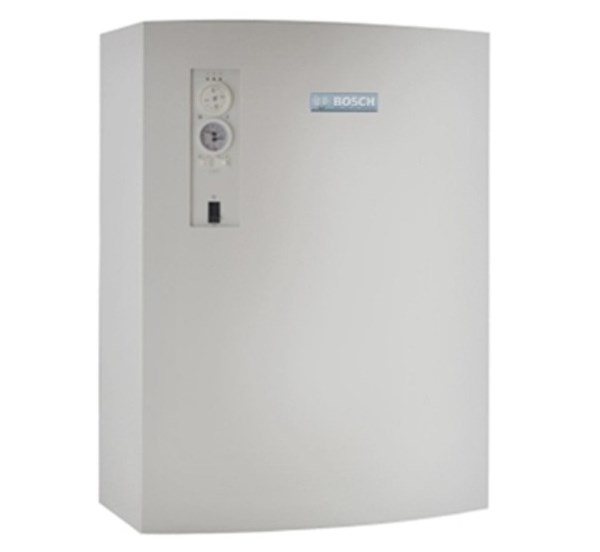

Bosch Tronic 5000 H
Single-circuit heaters are suitable for hot water supply using an indirect heating tank. The efficiency declared by the manufacturer is 99%. They provide water heating up to +90 degrees, four-stage power and temperature control using a room regulator.
Slovak boilers Protherm are distinguished by no less functionality and performance at an adequate cost. The same equipment is supplied by the Czech company Dakon - the Protherm 18K model, like the German ones described above, is equipped with a steel heat exchanger and automation, which provides even greater possibilities with the same efficiency. The boiler has the function of remote power supply control from the tariff meter.
Russia produces products that are not inferior in quality, but more affordable in terms of cost. The company SAVITR (part of NPK VETROSTAR) has been producing dual-circuit boilers of the Ultra series with weather-dependent automation and remote control with a GSM module since 2010. According to reviews, the quality and reliability are the highest.
Russian manufacturers have extensive service networks, which is important.
Calculation of heating costs
As mentioned above, economically an electric three-phase boiler is more expensive than its gas and solid fuel counterparts. Electricity rises in price by leaps and bounds.
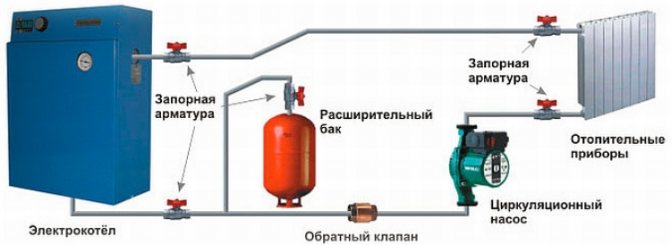

Electric boiler piping diagram
Calculate the flow rate for a month or heating season in the following way:
- given that the efficiency of most units is close to 100%, it is believed that to obtain a kilowatt of thermal energy, 1.03 kW of electrical energy will be required;
- the area of the house is divided by 10 and multiplied by this indicator;
- multiply the resulting value by the cost of one kW / h.(in different regions it is different), then by 24 (the number of hours of work per day) and the number of days in a month or heating season.
In theory, for a house of 100 square meters with a kilowatt cost of 3.2 rubles and round-the-clock work per month, about 26 thousand rubles will be required for heating. In practice, this amount should be reduced by about half - the boiler does not always work around the clock. The expenses will be even less for the apartment.
The video shows the installation procedure:
The material from which the house is built, the floors are made, the type of windows and doors, the quality of insulation have a great influence. It is not possible to take everything into account. Therefore, only practice will show how expensive the boiler will cost.
